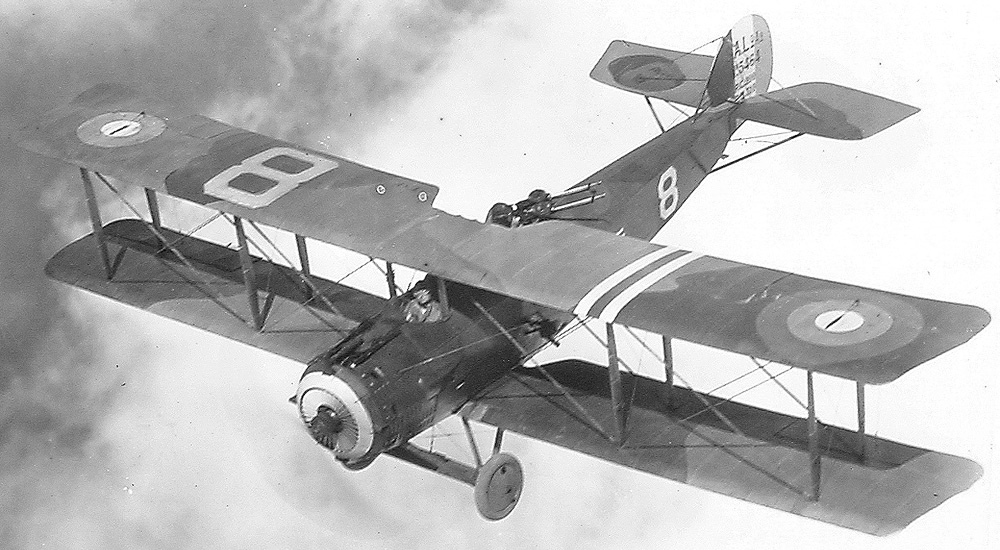A Space Force & Experiences with Airpower and the Great War
On June 18, President Donald Trump directed the Department of Defense to “begin the process” of establishing a Space Force as the sixth branch of the U.S. military, pushing into the spotlight recent discussion between Congress and the Pentagon about the need for a separate space component.

Published by The Lawfare Institute
in Cooperation With

On June 18, President Donald Trump directed the Department of Defense to “begin the process” of establishing a Space Force as the sixth branch of the U.S. military, pushing into the spotlight recent discussion between Congress and the Pentagon about the need for a separate space component. The debate pits concerns about the urgent need to counter Russian and Chinese advances in space warfare—exacerbated by the U.S. Air Force’s (USAF) alleged misprioritization of space missions and decentralized acquisitions process—against the immense cost and additional bureaucracy of an independent military space service.
But the creation of the independent USAF was itself fraught with debate. The tortured experience of developing American airpower is a cautionary tale that can inform not only the near-term decision of whether to reorganize U.S. military space assets, but also the potential pitfalls that could limit U.S. military effectiveness in future space warfare.
The U.S. was one of the first world powers to recognize the value of both military airpower and the technology behind it. Even before invention of the airplane by the Wright brothers and its subsequent purchase by the U.S. Army Signal Corps, the U.S. had set the stage for military airpower. In 1899, delegates to The Hague Peace Conference sought a categorical ban on aerial weaponry—at that time employed by hot air balloons—due to the dangers of indiscriminate bombing to civilians. The U.S., represented by Army Captain William Crozier, insisted that the prohibition be limited to only five years so that militaries could employ airpower in combat once advances were made in the accuracy of air-based weapons.
Despite American recognition of airpower’s potential and pioneering of air technology, the U.S. military viewed airpower solely in a supporting role to land and sea warfare. As a result, the U.S. military used unarmed aircraft to perform the same missions for which it later employed satellites: reconnaissance and communication. But U.S. restraint with offensive airpower doctrine and capability did not discourage other military powers from militarizing the air. As the U.S. military watched World War I transpire from the sidelines, it failed to respond as its German adversaries developed armed aircraft that could threaten reconnaissance and communication aircraft. The weaponization of aircraft ultimately caused all major powers to develop pursuit aircraft intended to fight other militaries in the air, rather than using aircraft only to supporting land and sea operations.
However, U.S. airmen entered the war poorly equipped, unprepared and in inconsequential numbers relative to the Central Powers. The lack of competitive U.S. aircraft designs, along with low production capacity, forced U.S. airmen to fly British and French aircraft. The U.S. remained a step behind other powers in development of military air doctrine until the end of the war.
Evolution of the air as an independent warfighting domain—eventually to the point at which entire battles could be fought in the sky—continued throughout World War I with little leadership from and adaptation by the U.S. military. Instead, Germany was the first to recognize the value of strategic bombing in targeting its enemies’ war economies and diverting valuable air assets away from the battlefield to homeland defense. From 1915 to 1917, the Germans conducted strategic airship and Gotha bomber raids on London, killing numerous civilians and triggering a British debate over whether the two British air services—the Army’s Royal Flying Corps (RFC) and Royal Naval Air Service (RNAS)—should be consolidated into an independent service. The RFC and RNAS, preoccupied with offensive combat operations elsewhere, had left few aircraft to defend London, and even after the attacks only reluctantly diverted aircraft from the front lines to defend Britain. A high-profile military investigation conducted in response to public outrage over the bombing concluded that the RFC and RNAS should be consolidated in an independent Royal Air Force (RAF). Senior British military airpower advocates like General Hugh Trenchard, the then-commander of the Royal Flying Corps, initially opposed efforts to create an independent RAF. However, public opinion—incited by the trauma of the bombing—proved decisive. Trenchard, who had already embraced the value of offensive air operations and strategic bombing, subsequently embraced the RAF as the best organization to further the development of British airpower.
Trenchard’s American counterparts had also realized that strategic bombing and the air as an independent warfighting domain had fundamentally changed warfare. But the U.S. had not similarly suffered from the Germans’ advances in strategic bombing, and therefore senior U.S. military officials were not likewise forced to adapt the dogmas of land and sea-based operations to airpower as an independent domain. Moreover, the expedited end to the war after U.S. entry prevented a compelling demonstration to U.S. military leaders that adaptation to the changes airpower had wrought on warfare would require an independent USAF. As a result, post-World War I development of U.S. airpower capabilities continued to deteriorate from under prioritization and under resourcing in the Army and Navy. Only Congress, with its constitutional authority to organize the military, could overcome entrenched U.S. military leaders and create an independent USAF.
In 1919, Brigadier General William “Billy” Mitchell and civilian airpower advocates alerted Congress to the need for an independent USAF, rousing a debate with senior military leaders. Congress was initially interested in an independent USAF as a method of eliminating redundancies in the Army and Navy air services, but later pursued its establishment on two additional grounds. First, the legislature adopted the vision of the air as an independent domain that required commensurate reorganization of U.S. military airpower; and second, it was concerned about the slow, inefficient and ineffective aircraft production and acquisitions that had plagued the U.S. military during the war. Airpower advocates argued that consolidating aircraft acquisitions in one service would reduce duplicative expenditures on research and development, diminish conflicts of interest, best prioritize aircraft development, and allow for the coordination of aircraft production that would offer the consistency required to keep private aircraft manufacturers in business. Entrenched opposition by senior military officials to Congress exacerbated the debate, and the legislature was only further emboldened when Secretary of War Newton Baker opposed an internal military commission’s recommendation that an independent military air department be established in order to maintain a successful aircraft development and acquisitions capability.
Baker was not alone. Secretary of the Navy Josephus Daniels, then-Assistant Secretary of the Navy Franklin D. Roosevelt and the General Staff of the Army all resisted Congress’s efforts to create an independent USAF. Between 1926 and 1933, Congress introduced 29 ultimately unsuccessful bills that sought to provide more freedom to military airpower. In the interwar years, U.S. aircraft acquisitions continued to suffer without a unified air department to manage them; when Roosevelt, now president, ordered increased aircraft production in anticipation of World War II, there were few aircraft types designed and few facilities, tools and people to make them. Roosevelt later acknowledged the validity of many arguments made in support of Congress’s interwar efforts when he honored Mitchell with a posthumous promotion and nomination for the Congressional Gold Medal.
It was not until the end of World War II that the offensive value of U.S. strategic bombing and the development of nuclear weapons—deliverable only by aircraft at that time—convinced senior military leaders of the need for unity of command in an independent USAF. And even the creation of the USAF did not end the entrenched opposition by the Army and Navy to loss of resources; turf wars between the services did not dampen until the Key West Agreement and B-36 controversy, which allowed the Army, Navy and Marine Corps to retain internal airpower capabilities.
Although the recent debate over a Space Force is different in many ways from the U.S. experience with airpower, the latter can inform the ongoing conversation on the president’s plan. Both proponents and critics of an independent Space Force have agreed that the U.S. must bolster its military space capabilities in response to actions by China and Russia, which have both developed anti-satellite and space weapons in the face of U.S. restraint. Supporters of existing restraint—the decision not to develop offensive space-to-Earth and anti-satellite weapons, on the grounds that this would encourage a space arms race—have argued that the U.S.’s near-monopoly in space would only diminish as U.S. becomes more aggressive and focused on space warfare.
Defense Department leaders, especially within the USAF, have strongly opposed a Space Force. In 2017, legislation introduced to create a Space Corps incited rare formal disagreement in the form of letters to Congress from both Secretary of Defense Jim Mattis—who recently downplayed his reluctance to establish a new service branch in the wake of the president’s announcement—and Secretary of the Air Force Heather Wilson. Former Secretary of the Air Force Deborah Lee James recently weighed in as well, acknowledging the challenges facing military space activities but opposing the creation of a separate Space Force.
While these arguments have independent merit, they also echo warnings made by these officials’ predecessors post-World War I that an independent Air Force service would increase bureaucracy and disrupt integration of warfighting capabilities between the new and existing domains. Today, these warnings are viewed in hindsight as parochial and overly conservative. Notably, outspoken advocates of an independent Space Force do not appear to have yet emerged from within the military.
Space Force proponents have also argued that development of space systems has suffered under the USAF acquisition system, which faces a shortage of suppliers and is slow compared to that of adversaries. These arguments likewise echo concerns over complicated, slow and inefficient acquisitions of aircraft during World War I. Advocates of an independent Air Force advanced reorganization as a tool to streamline procurement processes and decisions. Though they failed to achieve an independent USAF at that time, they succeeded in continuously reorganizing airpower within the Army Signal Corps to fix these problems, and ultimately convinced Congress to centralize aircraft acquisitions in 1926.
Skeptics of a potential Space Force have made the case that the U.S. military has yet to develop the coherent spacepower theory and doctrine necessary to guide space acquisitions. Furthermore, they argue that an independent Space Force will be necessary only when U.S. space capabilities can produce significant direct combat effects—affecting the enemy with direct results on the battlefield— independent from, and in contribution to, joint operations with the other armed services. The inability to satisfy these conditions similarly burdened the effort to create an independent Air Force. While U.S. airpower saw combat in World War I, senior U.S. military leaders had not yet bought into the potential value of strategic bombing before the armistice and U.S. bombers had not yet achieved unique combat effects. It was not until after these conditions changed in World War II that the independent USAF was finally born.
The debates over an independent USAF were incited by U.S. victories in two of the most destructive wars in history. The debate over a Space Force does not benefit from the clarity of recent combat, but the experience of developing American airpower after World War I offers relevant historical experience and color. The organization of the U.S. military is a function both of lessons learned from past conflicts and prescient planning for future ones. In the case of airpower, an independent service did not come to fruition without numerous conditions—not all of which may yet be satisfied by the Space Force. At the same time, change may be needed to meet modern threats. The history of American airpower can inform not only analysis of when the United States might truly need a Space Force, but also the challenges the military may face along the way.



.jpg?sfvrsn=cb803a66_6)

